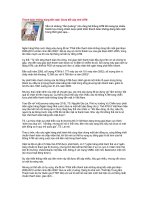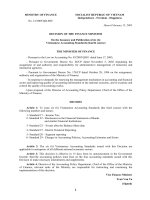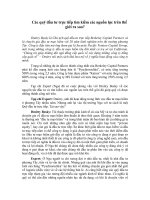THE MANAGING BUDGETS POCKETBOOK doc
Bạn đang xem bản rút gọn của tài liệu. Xem và tải ngay bản đầy đủ của tài liệu tại đây (1.15 MB, 113 trang )
THE
MANAGING BUDGETS
POCKETBOOK
By Anne Hawkins and Clive Turner
Drawings by Phil Hailstone
“A clear presentation of ‘how to’ in an area of management where there are so many
examples of ‘we didn’t’. It successfully deals with a subject area that is either
mystique-ridden or handled too simplistically, showing that budgets are based on a series
of practical management decisions rather than on one simple technique”.
Peter Nicholls, Head of Investors In People, Walsall Training & Enterprise Council
“Typical of Clive’s excellent teaching standards. It deals with a critical process in a very
readable style, and reflects the very practical experience that both authors have gained
in their careers”.
Andy Stevens, Chief Operating Officer, Messier-Dowty International
CONTENTS
INTRODUCTION 1
FINANCIAL PLANNING 7
What is a Budget, need to plan,
planning for profit and cash, challenge
process, continuous review
REVENUE BUDGETS 29
Budget saboteurs, golden rules,
four stages of setting budgets,
input-output analysis, revisions,
monitoring and controlling
CAPITAL BUDGETS 55
Strategic fit, preparation, authorisation,
evaluation, link to other budgets
PRODUCT COSTING 63
Why it is important, how to
understand the system, challenge
the system, be flexible
APPENDIX ONE 100
Business Financial Model
APPENDIX TWO
Product Costing Example 103
NB
INTRODUCTION
1
INTRODUCTION
ARE YOU MANAGING?
Are you managing your business or is your business managing you?
Do you plan what you are going to do or just react?
2
INTRODUCTION
FAILURE TO PLAN
Has this happened in your business?
Why did it happen?
3
INTRODUCTION
CO-ORDINATE AND CONTROL
Planning is essential for businesses to co-ordinate and
control their activities.
Co-ordinate
Businesses are run by a group of individuals, each of
whom will have a personal view of the best way ahead.
If there is no agreement on where the business is going,
and how it will get there, the team cannot pull together.
Control
Businesses need to measure their progress against
their plan in order to reassess how they are going
to arrive at the agreed destination.
4
INTRODUCTION
CLASSIC CLICHÉS
“I’m too busy to plan” perhaps you’re too busy because you don’t plan!
“My boss plans. I get on with it” but are you pulling in the same direction as the
rest of the team?
“Just get the sales” which sales? Are they profitable? Will the business be
worth winning?
“What’s the point? Things never go according to plan” by planning you are focused on
the future and will respond quicker to the changing environment.
5
INTRODUCTION
PLANNING IS FOR EVERYONE!
Remember
Even the smallest cog in the largest wheel has a vital role to play in the planning process.
Don’t underestimate the significance of your contribution and the damage that can be
inflicted if you get it wrong!
6
FINANCIAL PLANNING
7
FINANCIAL PLANNING
WHAT IS A BUDGET?
A budget is a management tool which underpins the planning and control process within
the business.
Definition:
A budget is telling your money
● Where to go
● Instead of worrying where it went
8
FINANCIAL PLANNING
IS IT NECESSARY?
● Is there a need to budget?
● Is it necessary to plan the finances?
YES!
A business is a sophisticated
money-making machine.
Don’t leave it to chance!
9
FINANCIAL PLANNING
NEED TO PLAN
Businesses have financial responsibilities
- to their owners
- to lenders
- to employees
- to suppliers
- to customers
Businesses must plan Profit and Cash.
● Will the business be successful?
● Will it meet its responsibilities?
● Will it satisfy the expectations of the owners?
● Will it be worth the effort?
10
These responsibilities must be planned!
FINANCIAL PLANNING
LONG-TERM AND SHORT-TERM PLANNING
● Businesses must plan for the long-term (the Strategic Plan) as well as the short-term
(the Business Plan)
● The Strategic Plan sets the ‘vision’ of where the business wants to be
in 3-5 years’ time
● The Business Plan sets out the steps the
business needs to take now in order to
move towards the strategic aims
● Financial Planning will be detailed at the
business plan level, more of an ‘overview’
at the strategic level
11
FINANCIAL PLANNING
PLANNING FOR PROFIT
WHERE TO START
● You need to persuade people to invest
● You need to examine the markets
● You need to design products/services
● You need to select facilities -
the tools to do the job
But you start with a plan!
12
FINANCIAL PLANNING
PLANNING FOR PROFIT
WHERE TO START
● People will not invest
● Banks will not lend money
Unless it is clear: - why you need the money
- that the scheme is viable
- that the financial outcome will meet your expectations and theirs
You start with a business plan
13
FINANCIAL PLANNING
PLANNING FOR PROFIT
THE BUSINESS PLAN
The Business Plan should ‘set the scene’ and state the short-term objectives.
‘Setting the scene’
● What will be your products/markets?
● Who will be your competitors? What will they be doing?
● Economic factors - inflation, interest rates, exchange rates, etc
● Technological changes - affecting your processes and/or markets
Short-term objectives
What are you planning to achieve in the short-term?
● Products - existing/new products
● Markets - existing/new customers
● Processes - existing/new methods of supply
● Employees - changes to skills-base
14
FINANCIAL PLANNING
PLANNING FOR PROFIT
THE BUSINESS FINANCIAL MODEL
The Business Financial Model explains how money works within the business.
Financial planning involves managing the model forward not just letting it happen.
See further Appendix One.
15
SOURCE OF FUNDS
USE OF FUNDS
SHARE CAPITAL LOAN CAPITAL RETAINED PROFITS
PRODUCTS / SERVICES
WORKING CAPITAL
Sales
Attributable Cost
Operating Profit
Interest
Tax
Earnings
Dividend
Retained Profits
Less:
Less:
Less:
Depreciation
FACILITIES / PROCESSES
FIXED ASSETS
THE
BALANCE
SHEET
PROFIT
and
LOSS
ACCOUNT
A summary of investment
in the business at a
specific point in time
A summary of Profit
Performance covering
a stated Trading Period
}
}
FINANCIAL PLANNING
PLANNING FOR PROFIT
LOGISTICS FLOW
Where do I enter the model?
Start with the products or services you are planning to sell. Think how you process and
deliver them to your customer.
Example
Which areas hold your business back?
16
PURCHASED
PRODUCTS
MATERIALS
LABOUR
MACHINE
CAPACITY
PRODUCTION
OUTPUT
FINISHED
GOODS STOCK
DISTRIBUTION
SALES
FINANCIAL PLANNING
PLANNING FOR PROFIT
LIMITING FACTOR
● Identify the limiting factor
This is usually sales - but could be capacity, labour skills availability, etc.
The limiting factor can change from year to year, eg:
Limiting factor What if you:-
- spend more on advertising
- cut the selling price of the product
- purchase extra machinery
- sub-contract work
- increase wages
- recruit from other labour markets (eg: overseas)
Part of the challenge process (see page 26) is to argue these ‘what-ifs?’.
17
LABOUR SKILLS
CAPACITY
SALES
FINANCIAL PLANNING
PLANNING FOR PROFIT
LIMITING FACTOR
● Having identified the limiting factor you can now start to plan:
What income will I receive? - the Sales Budget
What will I need to spend in order to deliver the sales and achieve the other short-term
objectives? - the Expenditure Budgets
Note: CASH CAN ALSO BE THE LIMITING FACTOR! See page 24.
18
FINANCIAL PLANNING
PLANNING FOR PROFIT
THE SALES BUDGET
The sales budget is driven by sales forecasts compiled by sales people.
● Traditionally sales forecasts are optimistic!
● You need to take into account:
- Price(s) - Mix of product
- Volume(s) - Timing
● The budget must be phased to assess capacity/workload implications
● Don’t forget to allow for customer credit in budgeting cash receipts
● Challenge each of the components planned in the light of:
- the total market - track record - the competition
Note: The sales budget must be set in sufficient detail to allow the expenditure budgets
to be formulated sensibly. In a one-product business this is straight-forward. In a
multi-product business where products have dramatically different expenditure
implications, a detailed analysis of the planned sales is essential.
19
FINANCIAL PLANNING
PLANNING FOR PROFIT
THE EXPENDITURE BUDGETS
Planned expenditure is classified as Capital or Revenue.
Capital Budget - planned expenditure on the processes/facilities (Fixed Assets)
Revenue Budget - planned expenditure on the materials, labour and running costs
of the business
Compiling Capital Budgets and Revenue Budgets is dealt with in detail in later sections
of the pocketbook.
However - do be careful!
Capital and revenue budget-setting can be mistakenly seen as separate activities - but
each can have implications on the other, eg:
- buying a new machine (Capital) will affect maintenance, power, insurance,
etc (Revenue)
- using outside hauliers (Revenue) will obviate the need for new delivery vans (Capital)
Be consistent!
20
FINANCIAL PLANNING
PLANNING FOR PROFIT
LINK TO THE MODEL
Now feed the sales budget and expenditure
budgets into the model.
21
CAPITAL
BUDGET
SALES
BUDGET
SOURCE OF FUNDS
USE OF FUNDS
SHARE CAPITAL LOAN CAPITAL RETAINED PROFITS
PRODUCTS / SERVICES
WORKING CAPITAL
Sales
Attributable Cost
Operating Profit
Interest
Tax
Earnings
Dividend
Retained Profits
Less:
Less:
Less:
Depreciation
FACILITIES / PROCESSES
FIXED ASSETS
REVENUE
BUDGET
REVENUE
BUDGET
SALES
BUDGET
CAPITAL
BUDGET
FINANCIAL PLANNING
PLANNING FOR PROFIT
HAVE YOU MADE A PROFIT?
Use your product costing system to determine:
- given your revenue budget
- what will be the budgeted cost of your products?
And having set your sales budget
- will you make a profit on the products you plan to sell?
Note: Product costing systems are explained in a later section of the pocketbook.
22









